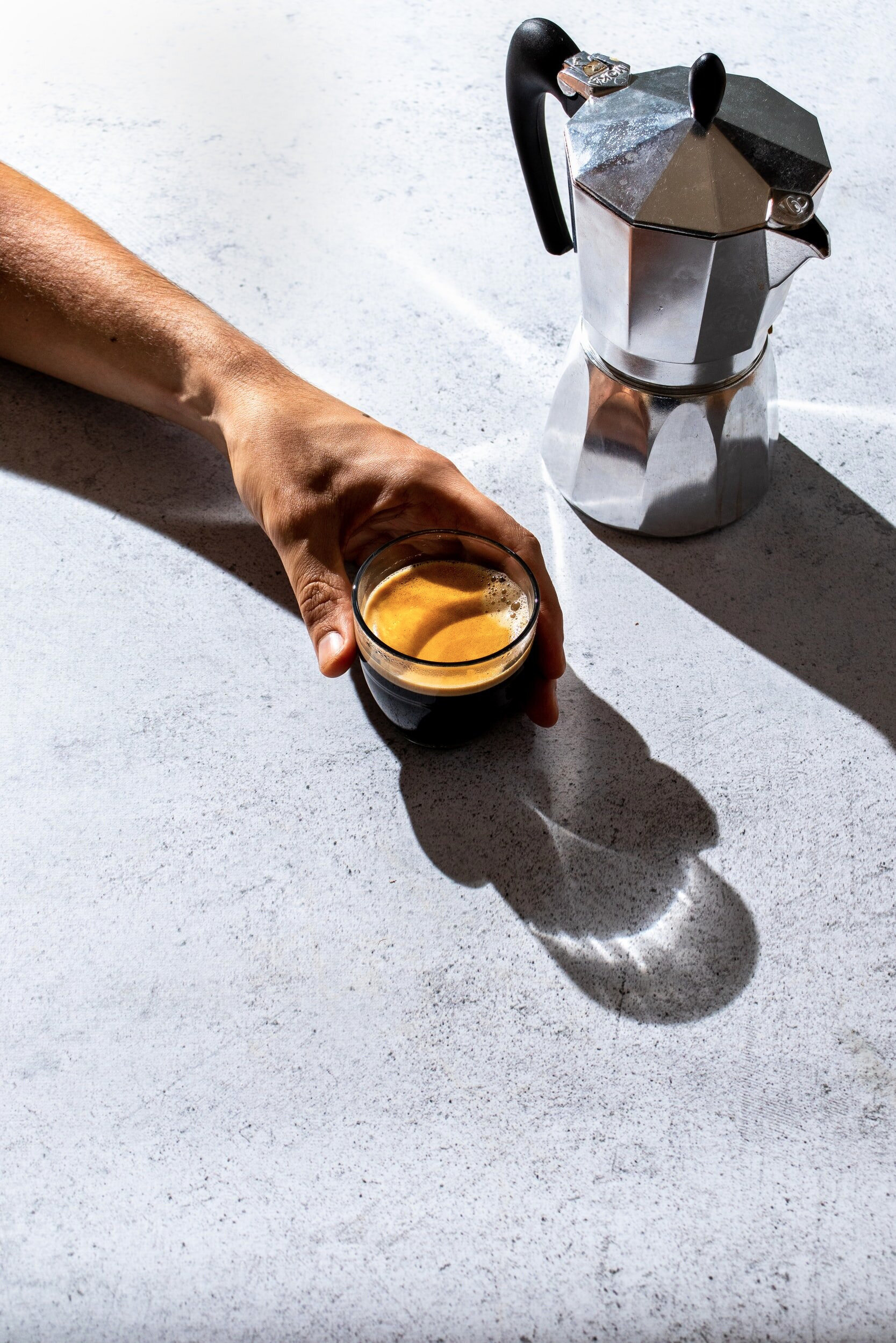Here are our tips for how to make the best coffee using this iconic coffeemaker. We call it a moka pot though it is also known as a Bialetti, after its creator, or stovetop espresso maker.
Even if you’ve never used a moka pot, chances are that its unique look has caught your attention.
Whatever you call it, the Moka Pot is a stylish, easy and tasty way to make coffee.
Here’s how to get brewing with the Bialetti - whether you’re going for an espresso, Americano or cappuccino-style cup of coffee.
The moka pot is typically made of aluminum, with a black Bakelite (plastic) handle and an eight-sided octagonal design. One is found in practically every household in Italy where it was invented in 1933 by engineer and coffee enthusiast Alfonso Bialetti. His namesake company has been making these ever since. You can also find moka pots made of stainless steel and other materials.
Its design is simple yet effective, consisting of three parts:
The base or “boiler”
The filter basket
The coffee collection chamber
This “stovetop espresso maker” produces a rich, full-bodied coffee, and its compact design is a stylish and space-saving addition to any countertop.
Why we love it:
DESIGN: Your coffeemaker is one of the first things you look at when you stumble into the kitchen half-awake to get your morning java fix.
The Bialetti has been featured as an example of efficient and innovative design in industrial art and design museums throughout the world, including the Museum of Modern Art in New York. Visually speaking, it’s a huge improvement over the cumbersome, boxy-looking plastic brewers that are fixtures in many Canadian kitchens.EASE OF USE: This coffeemaker is easy to use, simple to maintain, and takes up very little space. Bonus - it has no extra parts or attachments to create extra clutter on your kitchen counter.
THE COFFEE: Most importantly, the moka pot makes a great-tasting coffee!
With a higher extraction rate (i.e. a high volume of coffee produced in relation to the amount of grinds used) than most coffee makers, it produces a rich taste that could be described as “espresso-like”. However, despite sometimes being referred to as a “stovetop espresso maker”, it’s not actually espresso. A moka pot typically extracts coffee at a level of 1 or 2 “bar” (short for barometric pressure), whereas real espresso is extracted at 9 bar.
How to brew a perfect cup with your moka pot
What You’ll Need:
Moka pot
Pre-heated water
Finely ground coffee - a traditional Italian espresso-style coffee like our Globetrotter is preferred
A cool, damp cloth
How To Use a Moka Pot:
1: Pour water into the base, filling it to just below the steam valve (the little piece near the top of the base). This is important, as the valve allows steam to escape, and needs to remain unobstructed.
Pro Tip: Use hot water - from your tap or from a recently boiled kettle. Using hot water speeds up the brewing process and makes sure your coffee won’t overheat and burn. Burnt-tasting coffee is a travesty!
2: Fill the filter basket with ground coffee. You want to make sure the basket is full but not compacted - just level it off without pressing down. Overfilling the filter basket can give you a bitter & over-extracted coffee because it’ll take too long for the water to filter through.
IDEAL GRIND: FINE - a similar texture to table salt. .This is a similar grind to that used in an automatic drip coffeemaker - much finer than for a French press and coarser than needed for a true espresso maker.
Needless to say, using quality beans is the key to a good cup of coffee – Sparkplug’s Globetrotter espresso, Bullit Custom Dark or Deuce Coupe medium roast blends are all great choices for a moka pot.
3: Place the filter basket into the base and screw the top coffee collection chamber onto the base. If you’ve used hot water, be sure to use an oven mitt or cloth, as the base will be hot.
4: Place the moka pot on your stove, pre-heated to medium, and leave the lid open. You want a gradual extraction, so be sure your stove is not set at too high a temperature.
5: As the water heats up, it will push its way through the filter basket and start pushing a slow stream of coffee into the upper chamber.
It may take you a few tries to find the right temperature for your stove and moka pot. Experiment until you get it just right.
If the coffee moves through to the upper chamber quickly and spurts, your stove is set at too high a temperature. Initially, the coffee should stream out with a thick, golden-brown colour, and gradually become thinner as the brewing continues. Once the stream becomes a slightly pale, golden-honey hue, your coffee is ready. This is usually accompanied by a gurgling and slight hissing sound. If you hear a hissing sound much earlier in the brewing process, the heat is too low.
6: Remove the moka pot from the stovetop and immediately wrap a cold, damp cloth around the base or run it under cold water. (Be careful not to let any water enter the upper chamber!)
This stops the extraction process, and prevents the coffee from developing a metallic taste, ensuring you get a fairly concentrated, rich-tasting brew.
7 ENJOY! : Serve the coffee right away while it is hot and freshly made!
Coffee Pro Tips:
If you like your coffee on the sweet side, try adding sugar directly to the collection chamber. Play around with the amount of sugar until you find the perfect level of sweetness for your taste.
Let your moka pot build up a seasoning. Wash it using hot water only - don’t use soap. A darkish shiny film will build up inside the moka pot. This seasoning is made of natural coffee oils, which both increase the flavour and prevent any metallic taste.
Pick the right moka pot for YOUR coffee style and kitchen. Moka pots come in a variety of sizes. Each “cup” is really a “shot” of espresso or about 2 oz / 60 ml of coffee. A 6-cup is the most popular size and will produce about 200ml of coffee. That’s one nice-sized Americano or two small cappuccinos.
If your stove is induction, aluminum will not work and you should pick a stainless steel moka pot. Stainless steel is also better than aluminum for electric stoves. If your stove is gas, either aluminum or stainless steel will work well.Make a full pot every time. The size of the base and filter basket are designed with the ideal water-to-grind ratio in mind, and if you’re like me, having to measure out amounts before you’ve had your caffeine fix is a risky endeavour! Transfer any extra coffee to a thermal container – chances are you’ll want more later!
Recommended Sparkplug Coffees:
Globetrotter dark roast espresso
Bullit Custom Dark darkest roast blend
Deuce Coupe smooth & rich medium roast blend
Don’t forget to select FINE GRIND if we’re grinding it for you.
Don’t miss out on any of our coffee making tips: sign up for the Sparkplug Scoop email newsletter and brew with the best!
Of course you can unsubscribe any time! And of course we won’t use your info for anything except sending you Sparkplug news!



